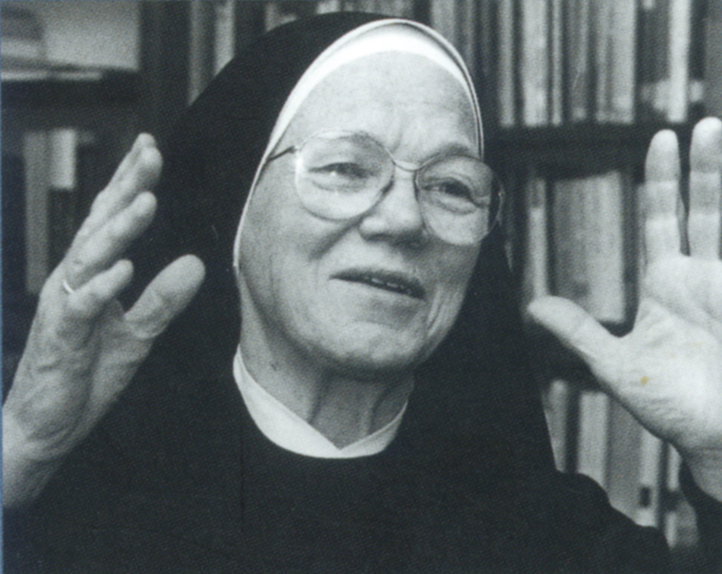Dr Erich Vermehren de Saventhem (23 December 1919-28 April 2005) was the founding President of the Foederatio Internationalis Una Voce, the International Una Voce Federation.
Professionally, he had been a diplomat, but also an ardent anti-Nazi and, like many anti-Nazis, he found a temporary safe place in the Abwehr, the German military intelligence organisation in which many German anti-Nazis worked clandestinely for the overthrow of the regime.
Dr de Saventhem was born in Lübeck to a family of Lutheran lawyers, later well-known for their opposition to the rising Nazi regime, then gradually gaining hold upon Germany and beginning to threaten the peace of Europe.
Once the Nazis came to power, the family were increasingly regarded as politically unreliable. Erich de Saventhem repeatedly refused to join Der Hitlerjugend, the Hitler Youth, so that he was prevented from taking up the Rhodes scholarship at Oxford University that he had won at the end of his school years.
Eventually, his passport was revoked, which made it impossible for him to leave Germany.
In 1939, following the example of his sister Isa, Dr de Saventhem converted to Roman Catholicism. His sister had been an actress and cabaret singer who lampooned the Nazis in her plays and songs. She was later imprisoned in the Nazi women's concentration camp at Ravensbruck but survived the ordeal to become a Sacred Heart sister and a teacher of the children of the poor.
Not long after, Dr de Saventhem met his future wife, Countess Elisabeth von Plettenberg, a member of an aristocratic Westphalian family, a leading member of Germany’s Catholic nobility. In Westphalia, the nobility were chiefly Catholic and the people largely Lutheran.
Many looked to the Roman Catholic nobility to give a lead and they were not disappointed. The Plettenbergs were therefore under constant suspicion and surveillance by the Nazis.
The couple married in October 1941, in a Germany then at war with the world and dominated by a fanatical Nazi government.
It was in 1967 that Dr Erich Vermehren de Saventhem became one of the founding members of the International Una Voce Federation, and was elected its first president.
Dr Erich Vermehren de Saventhem and his wife, Elizabeth (born Countess von Plettenburg) in 1940
The
Plettenburgs, as with virtually all of the Roman Catholic aristocracy, were radically
opposed to Hitler, and began clandestinely to distribute the banned 1937 papal
encyclical of Pope Pius IX, Mit
brennender Sorge (written by Cardinal Pacelli, former Nuncio to Germany and later Pope Pius XII) which condemned Nazi racial policies and which the
Nazi government had banned. Consequently,
Elisabeth’s parents were imprisoned by the Gestapo.
However, their daughter was
able to secure their release some weeks later by very careful diplomacy but the
result was she found herself under surveillance by the Nazi
regime.
Dr de
Saventhem soon found himself in touch with anti-Nazi circles and conspirators,
including members of the Kreisau circle. His cousin, Adam von Trott zu Solz,
another aristocratic opponent of the Nazis and a member of the German Foreign Office, was a prominent member of the secret opposition conspiracy that was planning to remove the dictator.
This conspiracy was known as Operation Valkyrie and this heroic story has been made into a Hollywood film starring American actor, Tom Cruise, as the central figure. That figure was another Roman Catholic aristocrat, Colonel Count Klaus Schenk von Stauffenberg, from a noble Swabian family, who was the cavalry officer who had laid the bomb to remove Hitler and his leading henchmen.
Tragically, the Attentat, the attempt on Hitler's life on 20 July 1944, failed and Adam von Trott was, with many others, subjected to a show trial before the Volksgericht, the so-called "People's Court" and sentenced by the odious Nazi judge, Dr Roland Freisler, to be hanged by piano wire at Ploetzenzee prison.
However, before those events had come to fruition, Trott had been able to come to the aid of Dr and Mrs de Saventhem.
Excluded
from military service because of childhood injury, Dr de Saventhem, in 1943,with the help of Adam von Trott, managed to get a job in the Abwehr, the military intelligence organisation whose head, Admiral Wilhelm
Canaris, was already making secret peace overtures to the Americans. Canaris had been doing this via the
German ambassador, former German Vice-Chancellor, Franz von Papen, another Roman
Catholic aristocrat. In addition, von Papen was a cousin of Elizabeth’s family.
It is small wonder that Hitler referred to the ancient aristocracy, particularly the Roman Catholic nobility, as "the Purple International" and regarded them as his arch-enemies, second only to the Jews whom the dictator was in the process of systematically destroying in what has come to be called the Holocaust or Shoah. It was clear to Dr de Saventhem and his wife and family that Roman Catholics were next, after the Jews, on the Nazi hit list for elimination and that good people would be equally powerless to prevent it.
Dr Erich Vermehren de Saventhem with Cardinal Ratzinger, Mr Michael Davies and Herr Ralf Siebenburger,
former presidents of the International Una Voce Federation
Von Papen
therefore arranged for Dr de Saventhem to take up a post as a junior agent in
Istanbul where the Abwehr station
chief was Paul Leverkühn, a fellow anti-Nazi. Elizabeth, however, had again
attracted the attention of the Gestapo and she was detained as a hostage,
against any subversion by any of her family.
Dr de Saventhem
now realised that he and his family were coming directly into the firing line
and might be arrested at any time and imprisoned or killed. It was time to
attempt to escape, if possible. He had made overtures to the British Secret
Intelligence Service, which, through its counter-espionage representative,
Nicholas Elliot, already had a file on him.
When they returned, on leave,
to Berlin, where the family home now was, Dr de Saventhem and his
wife agreed they would try to escape to Britain. His wife managed to obtain an
appointment to Istanbul on official business in connection with the visit of an
archbishop to Turkey.
Together,
they travelled by train to Istanbul, but at the border crossing into Bulgaria,
Elisabeth was again arrested by Gestapo agents and taken to the German embassy
in Sofia, though her husband was allowed to continue on to Istanbul.
In Sofia,
it transpired that the ambassador was a family friend who (in cooperation with
the Abwehr station chief) managed to
infiltrate Elizabeth on board a diplomatic courier plane to Istanbul.
They had
planned that their escape to Britain, in February 1944, would look like a
kidnapping. This was to avoid the deadly Nazi policy of Sippenhaft by which members of an escaper’s family were executed or
imprisoned for the deeds of the escaper.
They were
then smuggled to England via Aleppo, Cairo and Gibraltar.
British
propaganda organisations broke the news of the defection, hoping it would cause
havoc in Germany’s intelligence services, especially since the invasion of
Western Europe was imminent.
The Nazi
leadership were infuriated because it was believed that the couple had absconded with
the Abwehr's secret codes. Although untrue,
Dr de Saventhem nevertheless was able to give much valuable information to the
Allies about German intelligence operations.
The upshot
was that the Abwehr was absolished
at Hitler's command and its tasks taken over by the SS under Himmler.
Several
members of their families were arrested and interned, including Dr de Saventhem’s
parents, his elder brother Michael and sister Isa, and Elisabeth's youngest
sister Gisela. Fortunately, all of them survived the war.
Dr de Saventhem's sister, Isa Vermehren, had been an actress who lampooned the Nazis, and later converted to Catholicism; she was imprisoned in Ravensbruck by the Nazis but survived to become a nun of the Sacred Heart Order
The de
Saventhems were given accommodation in the South Kensington flat of the mother
of Kim Philby, then a senior member of MI6, where they provided him with lists
of personalities of the Roman Catholic underground in Germany.
Unfortunately,
as these Roman Catholic figures were as equally opposed to Communism as Nazism,
Philby, a Soviet spy, handed the list over to his Soviet handlers who then
caused most of them to be murdered.
The de
Saventhems also tried to persuade the British Foreign Office to allow leading
members of the German opposition to help in rebuilding the country but, due to the
ignorance of the British establishment as to the nature of the German underground
opposition (not least in the Foreign Office, then infiltrated with Communist
spies), they were unsuccessful.
In
protest, the de Saventhems then asked for their status as “Guests of the
Foreign Office” to be annulled and to be left to their own devices.
Elisabeth
found employment as an assistant teacher at Worth Abbey, a Roman Catholic public
school run by the Benedictine Order, while Erich founded a small export
company, which had limited success, and later found employment with a firm of
brokers at Lloyds of London.
They lived
in Knightsbridge near the famous Brompton Oratory in Brompton Road. Later, the
de Saventhems settled in Zürich in the 1960s where Erich managed his firm’s
Swiss subsidiary until he was promoted as Director for Europe in 1964.
They then
lived in Paris before moving back to Switzerland in 1966.
It was at
this time, in the immediate aftermath of the Second Vatican Council, that they
became active in the Catholic Traditionalist Movement.
Dr Erich Vermehren de Saventhem and his wife Elizabeth, born Countess von Plettenburg, with traditional Catholic author, Mr Michael Davies, later also President of the Una Voce Federation
It was in 1967 that Dr Erich Vermehren de Saventhem became one of the founding members of the International Una Voce Federation, and was elected its first president.
He and his wife both
worked tirelessly for the benefit of Catholic tradition until well into their
retirement. When Elisabeth’s health began to fail, they returned to Germany and
she died there in 2000.
It was
not until 2005, in the year of the election of the first German pope for 900
years, Josef Ratzinger, Pope Benedict XVI, that Dr de Saventhem was finally called
to his Maker, after years of service to the cause of Catholic tradition that
finally bore fruit during that pontificate.
The
testimony is clear that the work of Dr Erich Vermehren de Saventhem prepared the
way for the restoration of the traditional Roman rite of Mass, the traditional rites of the Sacraments and of the Roman
Office, in the motu proprio of Pope
Benedict XVI, Summorum Pontificum.
Traditional Catholics throughout the world should honour the memory of this courageous
and distinguished couple who so faithfully served the cause of truth and
Catholic tradition throughout their lives.
Requiem aeternam dona eis, Domine, et lux
perpetua luceat eis.
The arms of the Vermehren family





